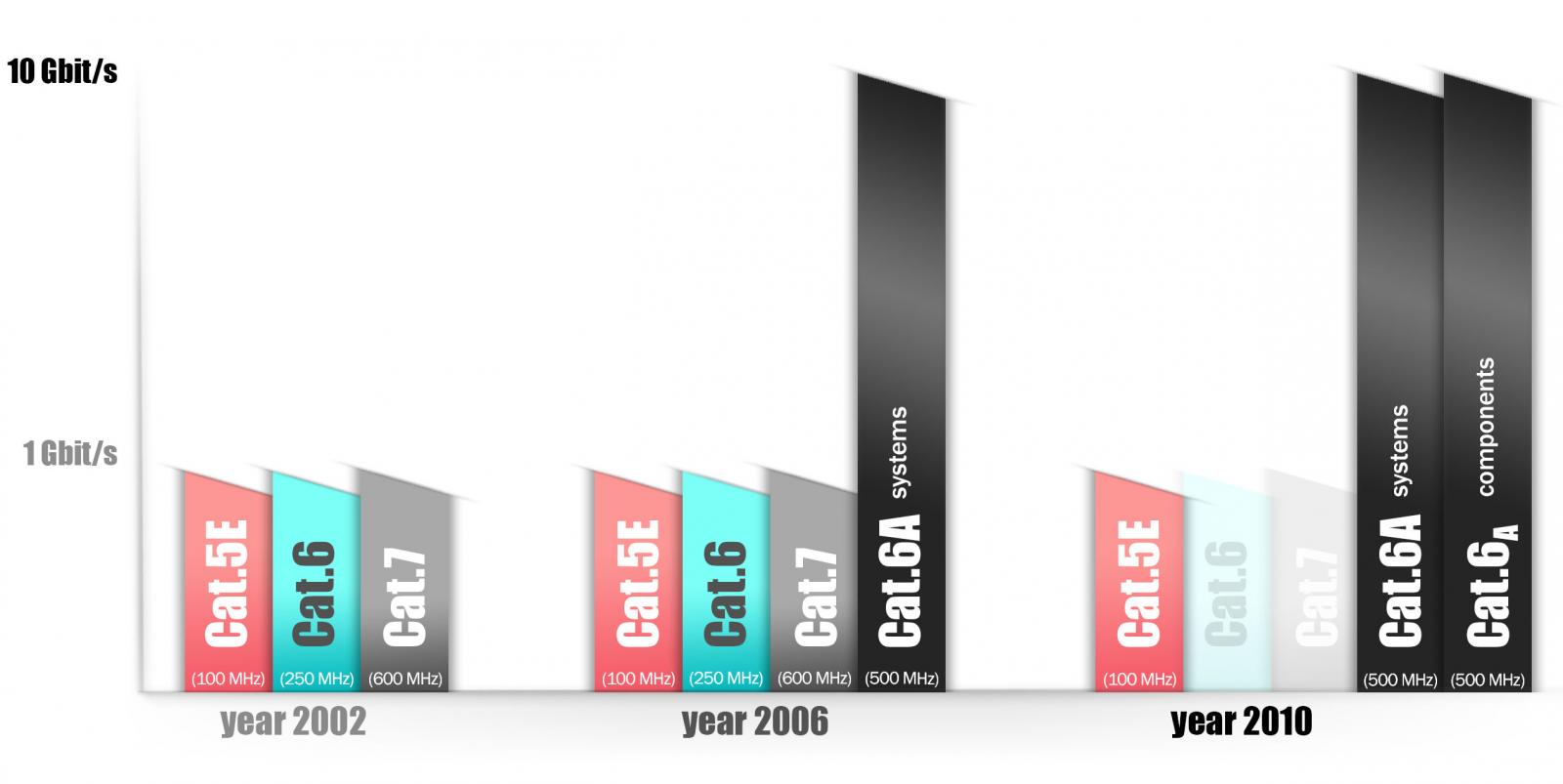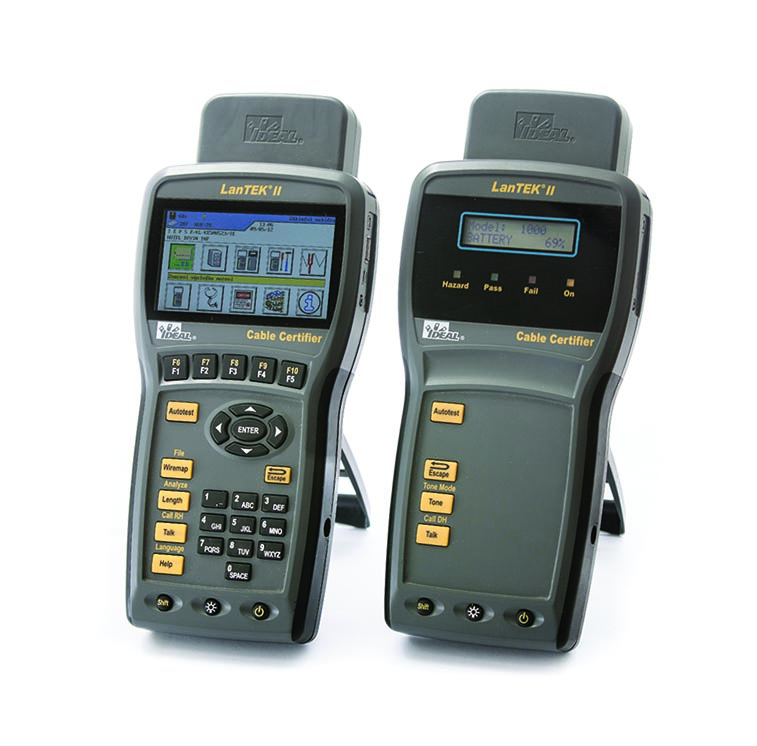1. Progress of Structured Cabling in Recent Years
Year 2002
Three Performance Categories Based on Transmission Band
In 2002, the international standard ISO/IEC 11801 divided structured cabling into three performance categories: Cat.5E, Cat.6 a Cat.7. The category Cat.5E was designed to fulfill requirements for all existing standardized protocols including the Gigabit Ethernet. Cat.6 and Cat.7 were created for upcoming high-speed protocols. Since a higher transmission speed requires a wider transmission band, a transmission band became the basis for cabling systems categorization. The division is as follows - 100 MHz for Cat.5E, 250 MHz for Cat.6, 600 MHz for Cat.7.Refer to the digram bellow for the situation in 2002

Transmission Speed as a New Criterion in Determining Cabling Performance
Research on a new protocol, 10 Gigabit Ethernet, soon showed that a transmission band is not a sufficient performance criterion for high speed data transmissions. The study detected a new unknown phenomenon called Alien Crosstalk, which was characterized by a cross talk among neighboring installation cables within a cable band, among close ports of patch panels, and among ports of outlets. This essential discovery revealed that cabling systems that don’t satisfy requirements for the Alien Crosstalk fail to transmit high-speed data; and thus, a transmission band was no longer the only performance criterion. In 2006, as a reaction, a new category Cat.6A (with transmission band of 500 MHz and defined maximal value of the Alien Crosstalk) was established for 10 Gigabit Ethernet and for others, with a speed above 1Gbit/s. Cat.6 and Cat.7, missing the Alien Crosstalk criterion, became obsolete and fell on the lower performance level Cat.5E. Hence, the new Cat.6A and the previous Cat.5E became the only useable categories.
Based on this discovery, the criterion for the cabling system categorization was shifted from a transmission band basis to a transmission speed basis. Refer to the diagram for situation in 2006.
A new standard has defined basic requirements for the 10 Gigabit Ethernet data transmission channel, enabling structured cabling producers to bring Cat.6A systems to market. The attributes/restrictions of Cat.6A systems are listed bellow:
- The performance category Cat.6A is guarantied only for a system as a whole.
- A system must contain only those components that the producer used to piece together the transmission channel certified in a testing laboratory.
- If components are used in a different configuration as stated in the certificate or are combined with components of other Cat.6A systems, no guarantee of transmission attributes or a performance category can be assured.
Separate installation cables, patch panels, outlets, and patch cables originating from Cat.6A systems don’t have the attributes suitable for Cat.6A components; therefore, reputable Cat.6A system producers call these by names derived from the commercial name of a system. These names (for example 10GPlus, Real10, and 10Giga) usually imply a transmission speed. On the other hand, there are numerous less respectable suppliers who call the components taken from Cat.6A systems Cat.6A components, and in this way create chaos in markets and confuse customers.
The introduction of the Cat.6A category meant that unshielded cabling producers needed to create new and superior systems. Only the best manufacturers found elegant and easy to install solutions. However, high quality shielded cabling producers didn’t need to develop a new product portfolio. Measurements proved that shielding eliminates electromagnetic interference of any kind including the Alien Crosstalk. Shielded Cat.6 and Cat.7 components thus became future-proof products with all the necessary attributes built-in before the attributes were discovered and defined by an international standard. Thus, shielded cabling producers could create and certify Cat.6A systems from already existing shielded Cat.6 and Cat.7 components.
Year 2010
Components Cat.6A / Cat.6A
As previously mentioned, the international standard from 2006 enabled manufacturing of Cat.6A systems even though the attributes of separate components had not yet been defined. It took another three years untill the committee found the criteria for transmission parameters of separate Cat.6A/Cat.6A components, their testing methods, and certification. A new amendment to the ISO/IEC 11801 standard was finalized in September 2009. The amendment was published in April 2010.The most important attribute of the Cat.6A/Cat.6A components is interoperability: each transmission channel made of the Cat.6A/Cat.6A components originating from various producers and brands is indeed the Cat.6A/ClassEA performance category.
Two Ways to Realize Cat.6A/ClassEA Structured Cabling
Nowadays, there are two ways to realize Cat.6A performance cabling:
- To install an integrated Cat.6A/ClassEA system
- To install interoperable Cat.6A/ClassEA components
Refer to the diagram for an overview of the situation in 2010.
The two possibilities are equivalent and supported by international standards.
Certification Objective in respect to Cat.6A / ClassEA Systems and Cat.6A / Cat.6A Components
Cat.6A performance is guaranteed for Cat.6A/ClassEA systems as well as Cat.6A/ClassEA components only when they meet the standards previously mentioned. Accordance with the standard can be assured only by testing and measuring in specialized testing laboratories. Customers can distinguish fake and real Cat.6A/ClassEA systems and Cat.6A/ClassEA components only based on certificates from independent testing laboratories. It is therefore a best practice to require these certificates from the supplier. With regard to the Cat.6A/ClassEA system, one certificate assures the entire transmission channel and the case of components, each component is certified separately (in some cases in groups of the same product line).
To identify Cat.6A/ClassEA systems, components taken from Cat.6A/ClassEA systems, and real Cat.6A/ClassEA components one needs to pay close attention to the text in certificates. Table 1 provides an aid to identify these.
Table 1
| Subject of certification | Obligatory references to international standards | Required texts referred to in the cerficate | U.S. standards cited for information only |
|---|---|---|---|
| System Cat.6A/Class EA | ISO/IEC 11801 yyyy amendment 1 (yyyy - year of issue 2002 and later) | “Two Connector Channel“, or “Four Connector Channel“ + list of all components comprising the transmission channel incl. P/N | ANSI/TIA/EIA 568-B.2-10 or ANSI/TIA/EIA 568-C.2 |
| single component Cat.6A/Cat.6A | ISO/IEC 11801 yyyy amendment 2 (yyyy - year of issue 2002 and later) | Single component, Category 6A with P/N | ANSI/TIA/EIA 568-B.2-10 or ANSI/TIA/EIA 568-C.2 |
Objective of Certification Measurements on Installed Cat.6A Cabling

The measurements on Cat.6A/ClassEA systems must be done as a Channel using patch cables from the given system. In the case of cabling composed of interoperable Cat.6A/ClassEA components, two options of measurements are available: Channel measurement (the same as in case of Cat.6A/ClassEA systems) and Permanent Link measurement. The advantage of performing Permanent Link measurement is that the certification can be completed without considering which patch cables will be employed by a user. The Cat.6A/ClassEA performance is guaranteed for each Cat.6A/ClassEA patch cable with no need for additional verification or measurements.
All testers feature international standards as well as the TIA/EIA standard valid in the USA. The US standard considers only unshielded solutions; and thus, the requirements for transmission parameters are set lower. Hence, when measuring on the installed cabling, it’s always preferred to set testers on the international standard ISO/IEC 11801 (as stated in table 2). Exceptions:
- Installations realized in the USA,
- Installations realized in countries where the national standard follows the TIA/EIA standard,
- Installations realized in headquarter, branch office, and subsidiary of an American company resident abroad
Table 2 illustrates proper settings on testers to certify (measure) installed cabling.
Table 2
| Type of cabling | Type of test | Certification acc. international standard | U.S. standard (informative) |
|---|---|---|---|
| Cat.6A/ClassEA system | Channel | ISO Ea 500 STP Chan | Cat 6A STP Chan |
| Installation on Cat.6A/Cat.6A components | Channel | ISO Ea 500 STP Chan | Cat 6A STP Chan |
| Installation on Cat.6A/Cat.6A components | Permanent link | ISO Ea PL2 (3) STP Perm | Cat 6A STP Perm |
2. Analysis and Critique of Markets
Causes of Ostrich Politics
Although it has been evident already for three years that Cat.6 doesn‘t serve its initial purpose, cabling in this category is still a bestseller in many markets. The argument that Cat.6 is more reliable than Cat.5E in transmitting Gigabit Ethernet is misleading; Cat.5E’s transmission band (100 MHz) has been set with a 20% reserve.
While Cat.5E satisfies less demanding customers, and Cat.6A satisfies customers in need of future-proof and high performance cabling, there is no reason whatsoever to offer Cat.6. An analysis was performed in four countries, Argentina, the Czech Republic, Hungary, and Slovakia, as to why Cat.6 is still being offered.
The number of Cat.6A/ClassEA installations is correlated to the number of unshielded cablings in the markets. As the number of unshielded cablings increases, the number of Cat.6A/ClassEA installations decreases. This may be the result of hiding the truth about Cat.6 and Cat.6A by advocates of unshielded solutions.
Other factors preventing the adoption of Cat.6A/ClassEA cabling include:
- Producers who don’t offer real Cat.6A (followers trying to copy and mimic original products) are a majority and use aggressive marketing strategies.
- The commercial interests of producers to profit as long as possible from a Cat.6 portfolio and in this way make full use of technology and past investments used in its production.
- A lack of professional information about product sold thorough modern distribution channels (e-business, warehouses, wholesalers).
- Big tenders and centralized purchases for state administration and multinational corporations which still follow old internal policies for building an organizations’ cabling infrastructure.
- Designers not reacting fast enough to frequent changes in structured cabling standardization.
- Acquisitive and short-term approach of many installation companies with this philosophy: ‘‘If we install Cat.6 today, we will get another order in a few years to install Cat.6A/ClassEA“.
From the four analyzed countries, with the expect ion of Slovakia that has strong dominance in shielded cablings, the Czech Republic also moved towards Cat.6A solutions. In these countries, consulting companies participate in the selection of buildings for their clients trying to recommend facilities plants with quality and future-proof IT infrastructure. Other proponents of Cat.6A include numerous system integrators and IT companies. These entities understand the simple nature of Cat.5E and Cat.6 cabling installation and are concerned about the possibility of non-specialized entities, such as electricians, performing installations and taking away their business.
3. Components Taken from Cat.6A/Class EA are NOT Cat.6A Components!
Summary of changes in knowledge and international standardization in recent years:
- Transmission protocol became a determining factor for standardization requirements applied to transmission channel (cabling).
- Ethernet dominates and sets directions for future development in LAN communications.
- Performance criterion for cabling has been updating from the originally used transmission band basis to a transmission speed basis.
- The use of Cat.5E for transmission up to 1Gbit/s and Cat.6A for transmissions above 10 Gbit/s is justifiable.
- Cat.6 and 7 are “zombie’’ categories and their performance is on the same level as Cat.5E (transmissions guaranteed only up to 1 Gbit/s).
- Since 2006, Cat.6A category cabling can be realized as an integrated Cat.6A/ClassEA system.
- Some quality shielded Cat.6 or Cat.7 components can be used as building elements of Cat.6A/ClassEA systems.
- Since 2009, Cat.6A/ClassEA components exist and their essential characteristic is interoperability.
- Solutions realized as integrated Cat.6A/ClassEA systems and solutions based on Cat.6A/Cat.6A components are equivalent and both are supported by international standards.
